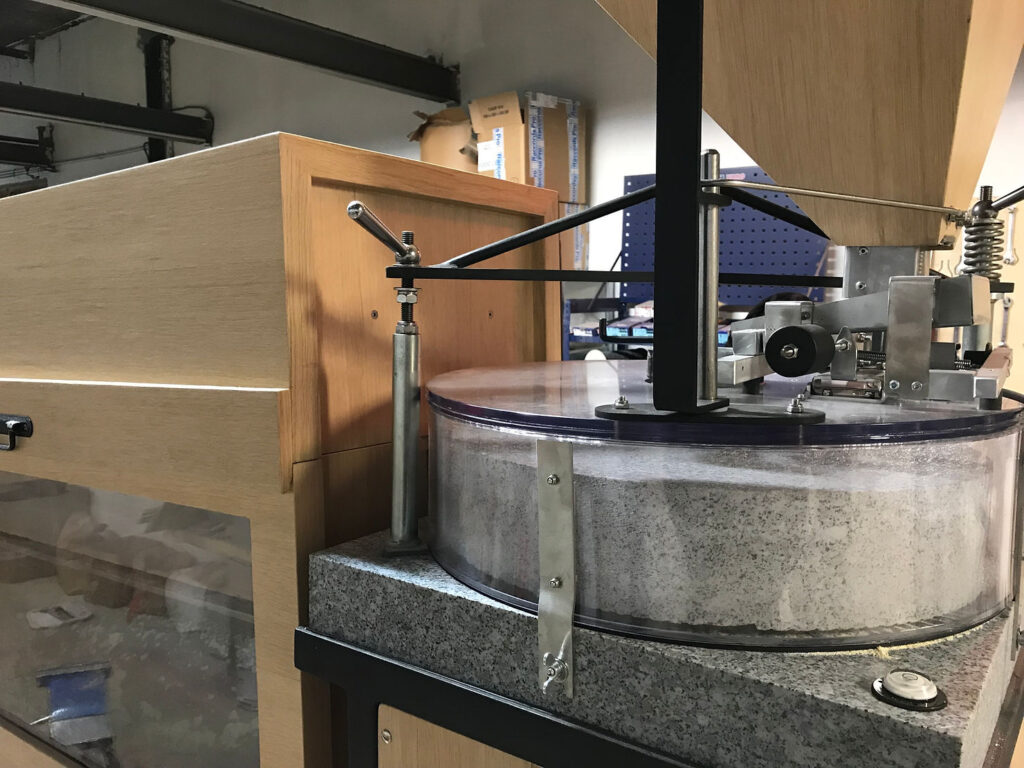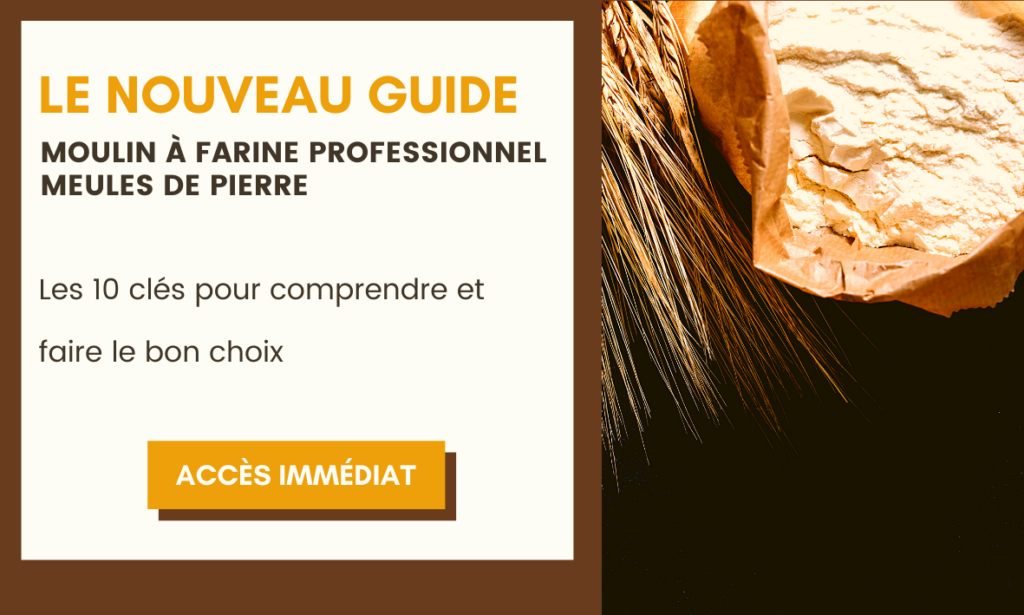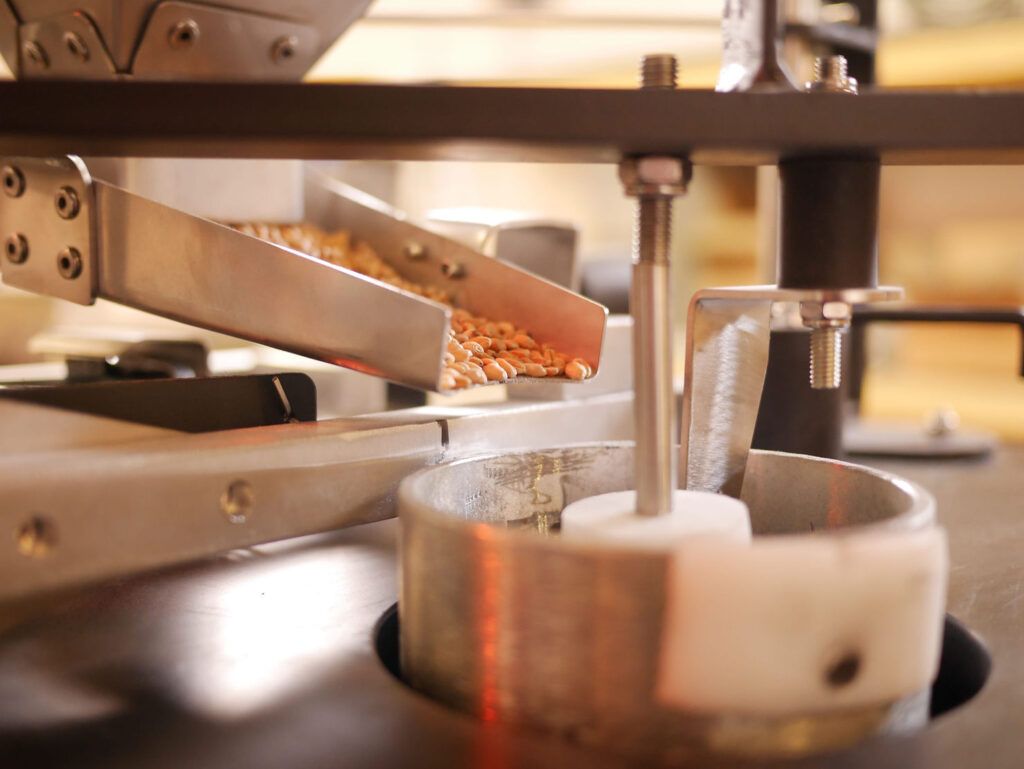If you only have two minutes to devote to reading this article, we can say that the first price of a new Astrié mill is around €10,500 excluding VAT. Second-hand Astrié mills are few and far between, and much more expensive than a new mill.
If you have more time to work out how to calculate your budget, here’s our detailed advice for your forecast.
How much does an Astrié mill cost? What factors need to be taken into account to make the right choice? What justifies the price differences between different manufacturers?
Step 1: Define your project in detail
Perhaps you’re a baker, a farmer baker or a cereal grower, you work in the catering industry or you want to set up a community grouping? To successfully define a budget, it’s essential to talk about your needs first.
Question 1: How many kilos of flour do you need to produce per day, per week, per month?
It’s vital to draw up a very simple forecasting table. In the first column, you need to know how many kilos of flour you’ll need and how often. Do you need a lot of flour once a month? Do you need a regular quantity every week? Do you need fresh flour every day for your business?
Note that stone-ground flour, and particularly Astrié mill flour, is a living flour, so it would be ideal to consume it within 6 months.
So answer this question:
- how many kilos of flour do I need, or do we need?
- How often do I need it?
These answers will have an impact on the size of mill best suited to your needs. Here are the first answers:
- If your requirements are around 6 tonnes of flour per month, or 1.5 tonnes of flour per week, or 300 kilos per 24 hours, then you should opt for an Astréïa mill with 50 cm millstones.
- If your requirements are around 12 tonnes of flour per month, or 3 tonnes of flour per week, or 600 kilos per 24 hours, and you’re switching to milling rights, then opt for the Astréia mill, with its 100 cm millstones.
The term ‘mill size’ is used, but in reality it refers to the size of the millstones.
The size of the millstone will depend on your flour requirements. For a 50cm Astrié mill, the price is around €10,500 excluding VAT.
With its 50 cm diameter grinding wheel, you can produce 15 kilos of flour per hour, or more than 300 kilos per 24 hours and 1.5 tonnes per week.
If you want to double this output, you’ll need a larger, 1-metre grinding wheel, which will allow you to produce 30 kilos of flour per hour. The price will be around €16,600 excluding VAT.
Question 2: What nutritional qualities do you want your flour to have?
Be careful, because on the market for stone mills, you need to distinguish between traditional stone mills and ‘Astrié’ stone mills. There are also other mills, such as Austrian wooden mills. Each mill has its advantages and disadvantages. The main thing is to make a conscious choice about the type of mill you use, depending on what you want to make. If you simply want flour, or if you want a non-oxidised flour, a local flour whose grain has never been oxidised, your choice will be different!
Let’s digress for a moment:
Is the difference between mills not clear to you? If you’d like to know the difference between an Astrié mill and a traditional stone mill, we’ve written an article comparing them.

There you are! Let’s get on with it!
If you just want flour, you could say that any mill that complies with health and food standards will do. The question now arises if you’re looking for a professional mill that will enable you to make :
- a flour that accurately reflects the grain you have
- a ‘terroir’ flour
- a flour that retains all the nutritional content of the grain
- a flour that retains all the germ of the grain
- a flour that is not oxidised or scalded
- a flour with a unique taste for your processed products (pasta, bread, biscuits, etc.)
- different types of flour (T80, T110, T130….) from a single mill
If that’s the case, you’ll have to go for a Moulin Astrié, like the one we make, because it’s the only one that can meet all these criteria.
Question 3: How can you tell an Astrié mill from another mill with stone wheels?
We talked about it a few lines above, if you need to compare mills, we invite you to read the article on this subject: ‘Comparing stone mills: can you tell the difference between an Astrié and a traditional stone mill?’
Often, one detail can make all the difference to the quality of the flour on offer: so to sum up :
- the stone of an Astrié mill is necessarily granite
- the stone on an Astrié mill is not self-sharpening
- there is NO ironing on an Astrié type mill: you never need to intervene in the grinding process
- the extraction rate is 80% in a single pass, the remaining 20% being the ‘bran’, the husk of the wheat which is put aside by an independent outlet on your mill
- each sieve produces a different type of flour (T110, T130, T80…): you change the sieve to change the type of flour. Changing sieves takes just a few seconds
A guarantee of quality, these conditions are essential for investing in an Astrié mill and not in a traditional stone mill (which has its advantages, of course, but does not meet the same objectives).
Question 4: Will you need to make different flours?
Depending on your project and the grind you want to achieve, you may need to arm yourself with different sieves to make different flours: T80, T110, T130, T65 for example! When you buy your Astréia mill, a sieve is included to make the equivalent T80 flour, which will be housed in the sieve box. There’s no need to add any other sieves if this flour suits you.

If you also want to produce semi-complete or complete flour, you’ll need a 470 micron sieve, which will enable you to make a T110 equivalent flour, or a 600 micron sieve, which will enable you to make a T130 equivalent flour, for example. You can also make T150 or 165 flour, the idea being that you can make the flour of your choice with a single mill.
If you want to market other types of flour, you can choose different sieves as extras. Expect to pay around €400 excluding VAT per sieve for a 50cm mill.
Question 4: Producing gluten-free flour?
If you want to produce gluten-free flour, you will need an additional sifting mill: one will be used to produce your traditional flour, and the other for your gluten-free flour. Health requirements are important, and having two sieves is essential if you are to meet them.
Question 5: Show your customers that you make your own flour?
If you want customers to see your mill in operation in your shop, during your open days, visits to your premises, farm visits (…), you can opt for translucent walls on your Astréia mill.
- The translucent walls of the archway allow you to show how the millstones turn
- The translucent walls of the flour mill allow you to show your visitors how the grain is transformed into flour, by gently unrolling it!
If you combine the two options, your customers and visitors will be able to see the whole journey from the seed to the mill and understand how the flour is produced. A real differentiator!

In this way, they see the flour fall into the hopper and complete its entire circuit (seed stored in the hopper, then passing between the millstones and finally emerging as flour).

Need advice on your purchase?
Often, to find the right Astrié mill for your needs, you need support and advice.
Depending on the cereals you want to process (rye, spelt, chestnut, wheat, buckwheat, soft wheat, durum wheat, maize flour, etc.), the micrometric gap between the two grinding wheels may vary.
In addition, depending on the output you need, extraction and bagging options may be useful. It’s also a good idea to draw up a layout plan, so that your project fits in perfectly with your premises. Once you’ve placed your order, training to understand how to operate the Astrié mill can also help.
In short, if you want to know exactly how to set up your project and be supported from A to Z, turn to a manufacturer who puts advice at the heart of the process. The service is just as important as the manufacturing itself!
What’s more, to answer any questions you may have, choose an Astiré mill manufacturer that allows you to visit the workshop, either face-to-face or remotely, so that you can immerse yourself completely in the world and understand all the specific features of this type of mill. Since this is a major investment, you need to know exactly where you’re heading!

Depending on your needs (organic flour, gluten-free flour, wholemeal bread production, yield level, etc.), the price of an Astrié mill can quickly change. For a model that already offers a good yield, expect to pay around €10,500: then, depending on your plans, let us guide you to find out whether you need additional bluteries or sieves! Get a free quote to get a clear idea of your budget. But be warned: choosing a second-hand Astrié mill is not the solution, and could cause your budget to soar.



